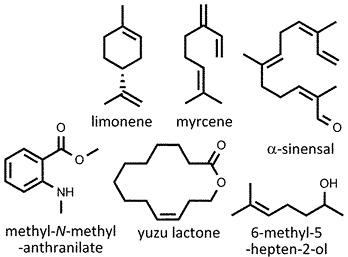 Citrus reticulata
Citrus reticulata
mandarin • tangerine
Back to “Spices: mandarin peel (Citrus reticulata)fr”
Citrus reticulata Blanco (Rutaceae); nartjie (Afrikaans); chu, ju, chieh (Chinese); mandarine (French); Mandarine (German); santara, suntara (Hindi); mikan (Japanese); mandarino (Italian); mandarina (Portuguese); mandarino (Spanish); som cheen (Thai)
DESCRIPTION Ripe fruits are easily recognized by the loose peel and fruit segments that can easily be peeled by hand.
THE PLANT A small tree with dark green leaves, white fragrant flowers and small, broad fruit. Various types of mandarins1 include the common mandarin or tangerine (C. reticulata, e.g. the popular ‘Clementine’), the satsuma mandarin or unshiu mikan (C. unshiu), Mediterranean mandarin (C. deliciosa) and king mandarin (C. nobilis). Hybrids include tangors (tangerine × sweet orange) and tangelos (tangerine × pomelo; e.g. ‘Minneola’ and the large-fruited Jamaican ‘Ugli’). The popular yuzu (C. ×junos), a hybrid between mandarin and possibly the ichang papeda (C. cavaleriei, formerly C. ichangensis).2
ORIGIN Mandarin probably originated in northeastern India or southwestern China. It has been grown at least since 1000 BC in China and spread from there to the rest of Asia (e.g. Japan, ad 1000) and Europe (early 1800s).2
CULTIVATION Mandarins are cold tolerant and are commercially cultivated in many countries.
HARVESTING Ripe fruits are hand-harvested during the very short fruiting season.
CULINARY USES Dry mandarin peel is a popular spice, used traditionally to flavour liqueurs, confectionery and sweet potatoes. Fresh fruits may be used in jams, marmalades, preserves, cooking, confectionery and cold drinks. The aromatic zest of yuzu (C. ×junos) is used in Japanese sauces (ponzu, yuzukosh), yuzu vinegar, yuzu syrup, yuzu tea, liquor (e.g. yuzukomachi), marmalade and as garnish with chawanmushi and miso soup. Sliced yuzu with honey and sugar are made into Korean yujacha (“yuza tea”). In Western countries, yuzu is gaining popularity as flavourant of carbonated drinks, beers, ciders and sweets. Oranges or candied orange peel (C. sinensis) provide the flavour for many famous dishes (e.g. sauce bigarade with roast duck), desserts, confectionery (e.g. orangine) and marmalades. Bitter orange (C. ×aurantium) is used for marmalade and crystallized (candied) peel and the rind oil in liqueurs such as Cointreau, Curaçao and Grand Marnier. Bergamot oil (from C. bergamia) is the flavourant in Earl Grey tea. The fragrant fruits of Buddha’s hand (C. media ‘Fingered’, a form of citron) are used in China to flavour sweets and tea.2 Chinotto is an Italian cola-like soft drink flavoured with C. myrtifolia fruits.
FLAVOUR COMPOUNDS The peels of mandarin, sweet orange and grapefruit all have limonene, myrcene and α-sinensal as major volatile compounds. However, the distinctive flavour of true mandarin peel (but not clementine)3 is ascribed to methyl-N-methylanthranilate.4 Yuzu peel has yuzu lactone and 6-methyl-5-hepten-2-ol as major aroma constituents.5

NOTES The bitter taste of navel orange juice, grapefruit and bitter orange is caused by flavonoids (respectively limonin, naringin and neohesperidin).
1. Saunt, J. 2000. Citrus varieties of the world. Sinclair International Ltd, Norwich.
2. Mabberley, D.J. 2008. Mabberley’s plant-book (3rd ed.). Cambridge University Press, Cambridge.
3. Harborne, J.B., Baxter, H. 2001. Chemical dictionary of economic plants. Wiley, New York.
4. Chisholm, M.G., Jell, J.A., Cass, D.M. 2003. Characterization of the major odorants found in the peel oil of Citrus reticulata Blanco cv. Clementine using gas chromatography-olfactometry. Flavour and Fragrance Journal 18: 275–281.
5. Song, H.S. et al. 2000. Quantitative determination and characteristic flavour of Citrus junos (yuzu) peel oil. Flavour and Fragrance Journal 15: 245–250.